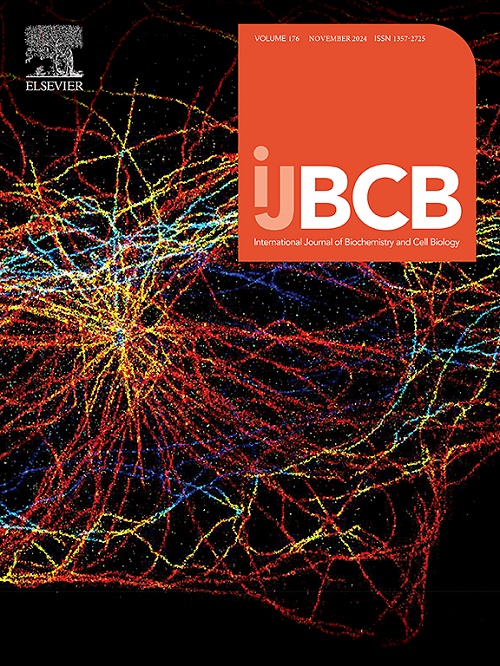p38 MAPK–mediated upregulation of claudin-3 and claudin-4 by gemcitabine contributes to chemoresistance in ovarian cancer
IF 2.8
3区 生物学
Q2 BIOCHEMISTRY & MOLECULAR BIOLOGY
International Journal of Biochemistry & Cell Biology
Pub Date : 2025-05-20
DOI:10.1016/j.biocel.2025.106805
引用次数: 0
Abstract
Chemotherapy is a primary therapeutic option in cancer treatment, but often associated with unwanted side effects and drug resistance. Claudin-3 (CLDN3) and claudin-4 (CLDN4) are essential components of tight junctions, frequently overexpressed in ovarian cancer, serve as potential therapeutic targets. In this study, we utilized flow cytometry, qPCR, Western blot, and animal experiments to investigate the regulation of CLDN3 and CLDN4 by chemotherapy drug, gemcitabine, in the ovarian cancer cell line A2780. We reported that gemcitabine can induce expression of CLDN3 and CLDN4 in ovarian cancer cells. Mechanistically, we showed that gemcitabine induces expression of CLDN3 and CLDN4 through p38 MAP kinase mediated transcriptional regulation. Overexpression of CLDN3 or CLDN4 functionally protected A2780 ovarian cancer from gemcitabine induced cell killing. It appears that gemcitabine induced expression of CLDN3/4 is a chemoresistance mechanism for cancer cells. Gemcitabine-induced upregulation of CLDN3/4 suggests that ovarian cancer cells may be more effectively targeted using claudin-3/4-specific antibodies or antibody-drug conjugates (ADCs) in combination with chemotherapy, which could have clinical implications for ovarian cancer treatment in the future.
吉西他滨介导的p38 mapk介导的claudin-3和claudin-4的上调有助于卵巢癌的化疗耐药
化疗是癌症治疗的主要治疗选择,但往往伴随着不良的副作用和耐药性。Claudin-3 (CLDN3)和claudin-4 (CLDN4)是紧密连接的重要组成部分,在卵巢癌中经常过表达,是潜在的治疗靶点。本研究采用流式细胞术、qPCR、Western blot、动物实验等方法研究化疗药物吉西他滨对卵巢癌细胞系A2780中CLDN3和CLDN4的调控作用。我们报道了吉西他滨可以诱导卵巢癌细胞CLDN3和CLDN4的表达。在机制上,我们发现吉西他滨通过p38 MAP激酶介导的转录调控诱导CLDN3和CLDN4的表达。过表达CLDN3或CLDN4可保护A2780卵巢癌免受吉西他滨诱导的细胞杀伤。看来吉西他滨诱导的CLDN3/4表达是癌细胞的一种化疗耐药机制。吉西他滨诱导的CLDN3/4上调表明,CLDN3/4特异性抗体或抗体-药物偶联物(adc)联合化疗可能更有效地靶向卵巢癌细胞,这可能对未来卵巢癌治疗具有临床意义。
本文章由计算机程序翻译,如有差异,请以英文原文为准。
求助全文
约1分钟内获得全文
求助全文
来源期刊
CiteScore
8.10
自引率
0.00%
发文量
124
审稿时长
19 days
期刊介绍:
IJBCB publishes original research articles, invited reviews and in-focus articles in all areas of cell and molecular biology and biomedical research.
Topics of interest include, but are not limited to:
-Mechanistic studies of cells, cell organelles, sub-cellular molecular pathways and metabolism
-Novel insights into disease pathogenesis
-Nanotechnology with implication to biological and medical processes
-Genomics and bioinformatics

 求助内容:
求助内容: 应助结果提醒方式:
应助结果提醒方式:


